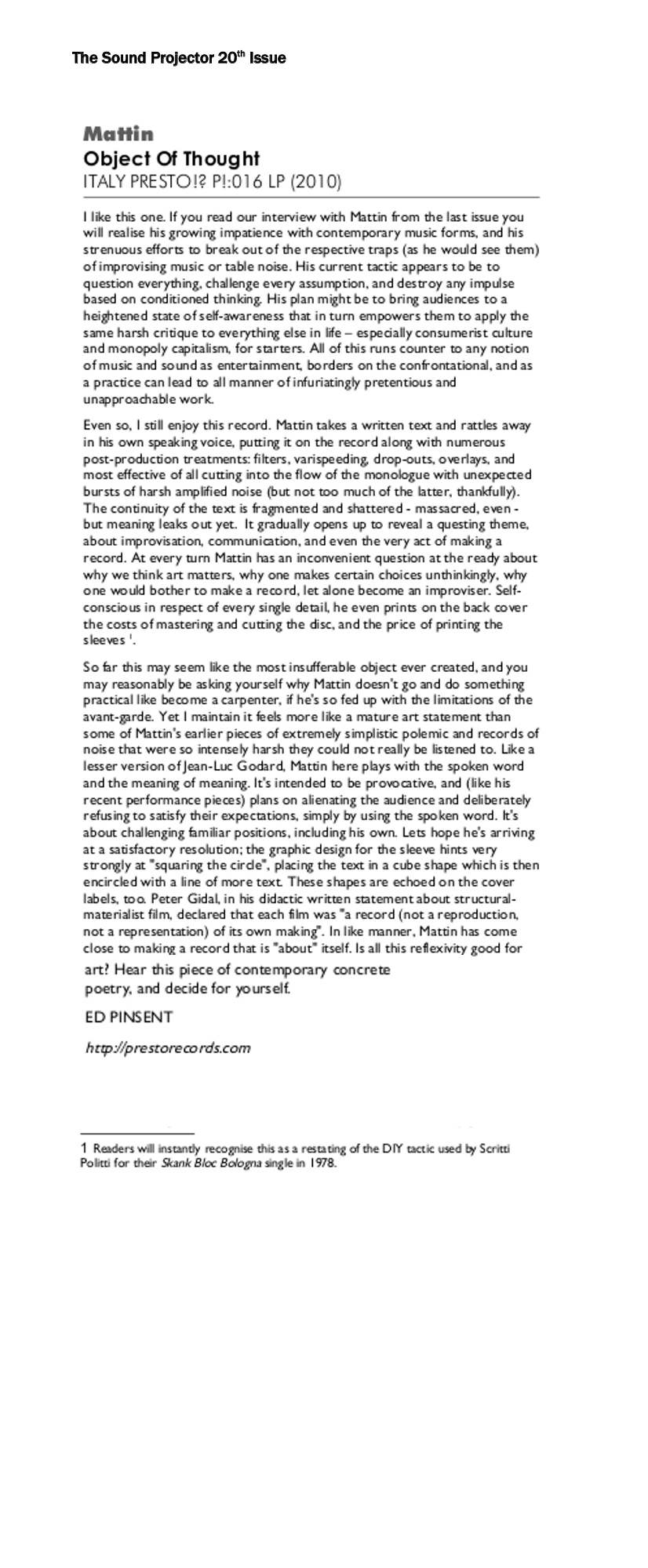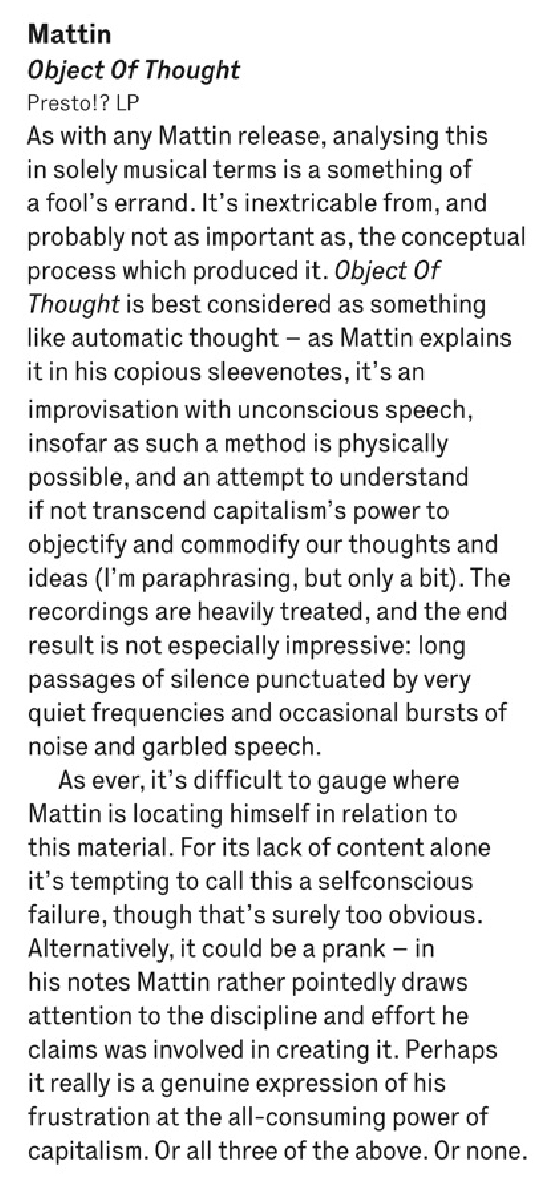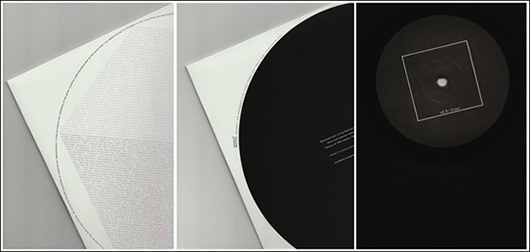
Mattin "Object of Thought"
total time: 30' 03"
http://www.prestorecords.com/
Side A
01) A
Side B
01) B
limited edition: 300
design: lorenzo senni
artwork concept: mattin
release date: 20/12/10
catalog number: P!?016
mastered by R. Becker
"...
Is it possible to take self-reflexivity to the point of positive
feedback while making a commodity out of my intellect? Can this process
help me to understand how I am objectified by capitalism? This is a
very difficult question, as I am using English which firstly, is not my
mother tongue, and secondly is the language more aligned
with
capitalism. To what extent does the use of English language shape my
thoughts and actions? If our general intellect is appropriated by
capitalism, can we get it back through a process of improvisation with
our thoughts? Can my unconscious be my instrument for improvisation?Can
we produce our subjectivity through the language that we are
improvising with? ... "
"... During the
first week of February 2010, from Monday to Friday, I appropriated
the usual working times (9 to 5pm) in order to set up a framework and
impose some discipline. I went to Alpha Electro-acoustic Studio,
Visby, I recorded my thoughts and then began to cut, edit, distort
... as a way of making a montage of my own subjectivity, as a way to
dismantle myself. If noise can contain everything it can also contain
my lack of articulation. By using my thought processes as material
for improvisation and then process them literally, I tried to explore
the limitation of the given situation, understanding that at the same
time I am objectitfying my thoughts in the vinyl that you are holding
in your hands."
(taken from the "Object of Thought" LP
front cover)
Object of Thought is part of this show:
BEAUTY AND THE BEAST OF BURDEN is an exhibition of 8 artists from UK,
USA, Sweden and Basque Country at Limousine Bull gallery, Aberdeen.
Curated by Dane Sutherland.
Limousine Bull, Aberdeen
20th May - 5th June
The opening night will include a LIVE AKTION by Kylie Minoise, as
part of an accompanying off-site installation, which may be visited
throughout the week.
The diverse mixture of emerging and internationally established
artists are brought together at Limousine Bull gallery in an exhibition
that explores the relationship between aesthetic representation and
activity. Here, activity encompasses fields such as activism; labour;
raw, abstract activity; and the active engagement of the 'viewer'. Can
the ugly truth of laborious activity be responsibly translated through a
criterion of beauty?
Reviews:
Non-musicology blog:
Mattin's
Object of Thought works as an x-ray of the flux of
thought. It is the diffraction of an objective perspective through the
sickness of our personalizing and objectifying internal thoughts. These
thoughts, as the sleeve notes point out, are the material for
improvisation. What we hear on this vinyl are recordings of Mattin’s
self-objectifying perspective. Nowadays Mattin's interventions and
performances almost always dispense from any aesthetic considerations in
the production of sounds, feeding the situations with conceptual
decisions and the material conditions of the events themselves.
Having this in mind, the first times that we listened to Object of Thought (OOT)
we did not get the shock that we were expecting. However, we were
surprised by the apparent attention put into audio editing – the “taste”
employed while choosing sounds and their timings. We almost understood
this as a lack of coherence relative to Mattin’s position regarding such
considerations. We were listening to a complex elecroacoustic- concrete poetry
composition with great richness and care put into its realisation. The
sounds that come from the vinyl are those of “quality” – this was
something that we were not able to fully understand in relation to our
expectations of Mattin’s album.
All this aesthetic content, along with the fragmentation and the
superimposition of voices in an unfamiliar language, made it difficult
for us to explore the questions that the record is manifesting.
In Mattin / Taku Unami’s CD
Attention their questions activate themselves in an immediate manner –and their intentions are explicit and crude – but
Object of Thought
needs a different type of implication for hearing in order for one to
become conscious of the challenge. To dismantle the aesthetic chokehold
requires one to consider this process as an expression of the attempt to
do a voice “evacuation”.
In the editorial introduction of Nick Land's book F
anged Noumena: Collected Writings 1987-2007,
the editors Robin Mackay and Ray Brassier analyze some of the aspects
of Land's text 'KatasoniX'. We find this helpful for the analysis of
OOT,
specifically with regards to Mattin’s attempt at “evacuation”. To
detail the performative evacuation of the voice, we quote at length:
As Nietzsche suggested, the structure and usage of the human
body is the root source of the system of neurotic afflictions
co-extensive with human existence; but bipedalism, erect posture,
forward facing vision, the cranial verticalisation of the human face,
the laryngeal constriction of the voice, are themselves all indices of a
succession of geotraumatic catastrophes separating the material
potencies of the body from its stratified actuality. Just as the bipedal
head impedes 'vertebro-perceptual linearity', the human larynx inhibits
'virtual speech'. One cannot dismantle the face [the material
representation of capitalism] without also evacuation the voice. Since
in geotramuatic terms, the human voice itself is-via the various
accidents of hominid evolution- the expression of geotrauma,
'stammerings, stutterings, vocal tics, extralingual phonetics, and
electrodigital voice synthesis are […] laden with biopolitical intensity
– they threaten to bypass the anthropostructual head-smash that
establishes our indentity with logos, escaping in the direction of
numbers.
Texts such as 'KataconiX'
accordingly attempt a performative evacuation of the voice,
disintegrating semantics into intensive sequence (notably through the
use of extracts from Artaud's notebooks, where 'poetry' slides into
delirious combinatorics). One of the tasks of schizoanalysis has now
become the decrypting of the 'tics' bequeathed to the human frame by the
geotraumatics catastrophe, and 'KatatxoniX' treats vestigal semantic
content as a mere vehicle for code 'from the outside': the 'tic'
symptoms of geotraumatism manifested in the shape of sub-linguistic
clickings and hissings. Already disintegrated into the number-names of a
hyperpagan pantheon, syncretically drawing on the occult, nursery
rhyme, anthropology, sf, Lovecraft, among other sources, the
'subterranean' current of impressions, correspondences, and analogies'
(Artaud) beneath language is now allowed uninhibited (but
rigorously-prepared) development, in an effort to corporeally
de-engineer the organicity of logos. [1]
To follow the
deformations of the voice and the way it might be camouflaged with the
noise between the vinyl and the needle – the alterations of pitch – is
to perceive how gender may be destroyed by the dilatation of tone. The
vocal range is the measure of the amplitude in which the records of the
human voice might be realized by the process of phonation.
The alteration of Mattin’s vocal pitch and tone on
OOT is a
transgender play that we mightn't overlook. Mattin’s digital editing may
be similar to the vocal cord surgery that some transsexuals might
consider undergoing in order to change the tone of their voice. The
transsexual woman that reaches puberty as man usually develops a vocal
resister that is characteristic of a "man". Hormonal therapy may not
change the voice of a transsexual woman once they have "masculinized".
For that reason, the transwoman with intentions of becoming a woman
might need vocal training or otherwise surgery in order to feminize
their voice.
Object of Thought displays Mattin’s non-surgical play with the full ensemble of vocal registers of the transgender.
In an interview for The Wire magazine, the dubstep musician Burial said about his track ‘Archangel’:
B: I like pitching down female vocals so they sound male,
and pitching up male vocals so they sound like a girl singing. It can
sound sexy as fuck.
W: That works. When I listen
to the record, I can’t work out whether the vocals belong to males or
females. And angels aren’t supposed to have gender.[2]
In
Object of Thought we don't hear angels singing; the voices comes from Genderqueers.
Formant frequencies for male, female, and male-to-female transgender speakers.
While listening to this record we were reminded of concepts
developed by German philosopher of mind Thomas Metzinger. In his book
Being No One: The Self-Model Theory of Subjectivity,
Metzinger questions “conscious experience”. The book analyses
first-person reports of a (sub) class of spontaneously emerging
neurological phenomena known as out-of-body experiences (OBE). We find
several points in common with Mattin's process in
OOT (the
materialization of his thoughts and subjectivity in/on the vinyl) and
Metzinger’s analysis of the first OBE (sub) model. According to
Metzinger, this constituent component-object (here is where we see the
link with the material object of
OOT) is a representation of the corporeal self from an external visual perspective (or, in the case of
OOT, sonic) that does not function as the centre of the global model of reality.
An OBE is non-parapsychologically perceived as one’s body is laying down
on a bed, path or surface without distortion or overdrive. Relatively,
Object of Thought
is not just about spatial self-representation and cognitive
self-reference materially expressed on the vinyl, but also an attempt at
subjective depersonalisation.
Kinematics of the phenomenal body image during OBE onset
Listening to
OOT is an exercise of uncovering the work, a
dissection of subjectivity; our game is the same played by Mattin when
he is objectifying his thoughts. Is not about perceiving the
construction of the object through a sick mannerism. On the contrary, it
is about dismantling the process of objectivation: the dismantling of
subjectivity through the evacuation of the voice. After some time, we
found that it was no longer necessary to ignore the recording’s formal
considerations in order to pay full attention to its content: the knot
between noise – as chaos and intelligibility – and the noise of
objectified thoughts.
The possibility of being assaulted by
unexpected harsh noise holds our attention throughout the whole
listening experience, but – as with Mattin's solo previous work like Proletarian of Noise or Broken Subject – this noise is beyond an ethics of volume. We will not find a passage where an abysmal noise gets unleashed.
The challenge is to maintain the cord taught, as tight as possible,
transforming the intellect in a commodity, while at the same time trying
to understand how we are objectified through capitalism.
Perhaps OOT
is a schizoid game, rigged with a traps disabling escape from the
“inside”, hiding the cracks whereby we might eventuate. In any case, OOT leaves us a carbon copy of subjectivity for analysis. Object of Thought
is an object/process of depersonalisation with traces of impact. About
these craters we can find a conceptual and epistemological approximation
to the reality of the record.
Mattin's identity is digitally processed while his subjectivity becomes abstract matter. The logos becomes numbers:
That's why stammerings, stutterings, vocal tics,
extralingual phonetics, and electrodigital voice synthesis are so laden
with bipolitical intensity-they threaten to bypass the anthropostrucural
head-smash that establishes our identity with logos, escaping in the
direction of numbers.[1]
If we take the idea of geotrauma,
which refuses the distinction between biology, geology, linguistics and
numeracy, we can see how the depersonalisation process on this record is
pushed a step further by Mattin’s conscious objectification of his
thoughts onto the materiality of the vinyl.
In
OOT Mattin's unconscious goes from the organic to the
inorganic, passing through digital 0s and 1s. Through this process,
Mattin's thoughts – his ego with neuroses and pathologies – are put into
the Poly-Vinyl-Chloride (CH2-CHCl)n, which itself has been going
through traumatic inorganic tensions arising from archaic
xenocatastrophes. Anthropocentricality becomes more and more redundant
in
OOT: the evacuation of the voice, its consequent
digitalisation and its fabrication into the LP mixes biopolitcs with
numeracy and geology.
The dehierarchisation process occurring in
OOT is at least triple:
- Thinking is multiplied by its insecurities and doubts: we can
hear that tics and stuttering are at the same level as the “better
articulated” thoughts.
- The evacuation of the voice is translated via digital processing (numbers) which are cut throughout the record.
- Finally these sounds are pressed into the vinyl, but the “silences”
allow that one can hear the material qualities of the vinyl itself
In conclusion, it is our opinion that Mattin’s
Object of Thought is as sonically refined as
Whitenoise (with Radu Malfatti), and as conceptually intense as
Attention (with Taku Unami).
Object of Thought is Mattin’s most complex release to date.
GegenSichKollektiv
Anti-Copyright
August 2011
[1] Nick Land,
Fanged Noumena, Falmouth: Urbanomic, 2011, p. 502
[2] The Wire, Issue #286 (Dec 07) | In Writing by: Mark Fisher | Featuring: Burial
URSONATE Nº 002 (Madrid)
Object
of Thought (OOT)
funciona como una radiografía del flujo del pensamiento. Es la
conquista de una
perspectiva objetiva sobre lo enfermizo del pensamiento interno, ese
pensamiento personalizador y subjetivante.
Lo
que escuchamos en la grabación es la voz de Mattin, objetivando sus
pensamientos en el vinilo. Esos pensamientos, que como se señala en
las notas de la portada, son el material de la propia improvisación.
Con las primeras escuchas que le dediqué al disco no recibí el
shock que esperaba.
Casi
en su totalidad, las intervenciones y performances de Mattin en la
actualidad prescinden de cualquier consideración estética en la
producción de sonidos, alimentando las situaciones de decisiones
conceptuales y de las condiciones mismas de esos eventos. Teniendo
esto en mente, me sorprendió la atención prestada a la edición del
audio, el “gusto” a la hora de escoger los sonidos y su
disposición en el tiempo, casi lo entendía como una incoherencia
con respecto a su posición ante estas cuestiones. Estaba escuchando
una pieza que juega con la electroacústica, la música y poesía
concreta, y que tiene una construcción formalmente compleja y con
una gran riqueza en su elaboración. El sonido que sale del vinilo es
un sonido de “calidad” y era algo que no acababa de encajar con
mis expectativas sobre el disco. Todo este contenido estético, junto
con la fragmentación y superposición de voces en un idioma que no
es el mío propio, me dificultaba profundizar en las cuestiones que
el disco pone de manifiesto. En “Attention” las cuestiones se
activan de manera inmediata, es explícito y crudo con sus
intenciones, pero Object of Thought necesita una implicación
diferente en la escucha para tomar conciencia del desafío.
Desmantelar el embozo estético requiere el tiempo que es preciso
para concebir este proceso como expresión del intento de
“evacuación” de la voz.
En
la introducción editorial del libro Fanged
Noumena: Collected Writings 1987-2007 de
Nick Land, se analizan ciertos aspectos del texto de Land,
“KatasoniX”. Encuentro de ayuda para el análisis de OOT y, en
concreto, este intento de “evacuación”, recurrir a lo escrito en
este ensayo sobre la evacuación performativa de la voz:
[…]
Uno no puede desmantelar la cara (la
representación material capitalista de la subjetividad)
sin evacuar también la voz […]
[…]“KatasoniX”
(del mismo
modo que OOT)
en consecuencia intenta una evacuación performativa de la voz, la
desintegración semántica en una secuencia [...]. Una de las tareas
del esquizoanálisis se ha convertido en tratar de descifrar la
catástrofe geotraumatica1 y KatasoniX trata el vestigial contenido
semántico como un mero vehículo para el cifrado de lo "desde
afuera": el "tic" sintomático del geotraumatismo1
manifestado en la forma sub-lingüística de chasquidos y silbidos
(que podemos
escuchar en la voz de Mattin a lo largo de todo el disco)
[…]
Recorrer
las deformaciones de la voz, cómo estas se camuflan con el ruido
como roces entre el disco y la aguja, las alteraciones en su altura,
se trata también de percibir cómo el género es destruido por
dilatación del tono.
El rango vocal es la
medida de amplitud de los campos que la voz humana puede llevar a
cabo en el proceso de fonación. La alteración de la altura y el
tono de Mattin en su voz es un juego transgenérico
que no debe ser pasado por alto. Esta edición digital de la voz es
similar a la cirugía que ciertos transexuales consideran realizar en
sus cuerdas vocales para cambiar su tono. Las mujeres transexuales
que llegan a la pubertad como hombres, usualmente se desarrollan
entre los registros de voz característicos de los hombres. La
terapia hormonal no altera la voz de una mujer transexual una vez que
se ha masculinizado, por lo tanto, las mujeres trans que tienen la
intención de hacerse pasar por mujeres necesitan tener ayuda con el
entrenamiento vocal o bien optar por la cirugía para feminizar su
voz. Mattin juega, por tanto, en todos los registros vocales del
transgénero.
En
una entrevista para la revista The Wire, el músico de Dubstep
Burial dijo sobre su tema ‘Archangel’:
Me
gusta bajar el tono de las voces femeninas para que el sonido sea
masculino y pitcheo hasta voces masculinas para que suene como el
canto de una joven.
The Wire: Eso funciona.
Cuando escucho el disco, no puedo averiguar si las voces pertenecen a
hombres o mujeres. Y los ángeles no se supone que tengan género.2
En
OOT no cantan ángeles; la voz proviene de Genderqueers.
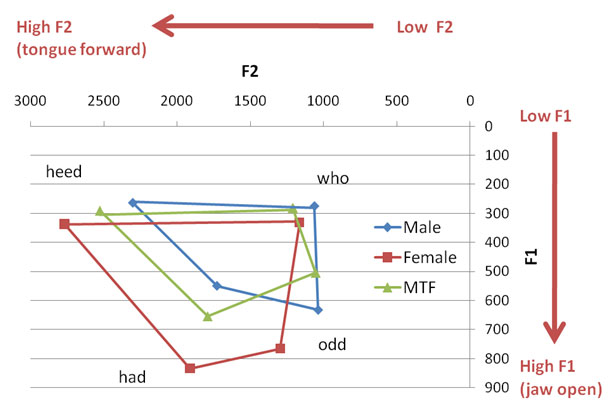
Formant
frequencies for male, female, and male-to-female transgender
speakers.
Durante las
escuchas del disco, también me vino a la cabeza continuamente las
ideas del filósofo de la mente Thomas Metzinger. En su libro Being
No One. The Self-Model Theory of Subjectivity debate en
torno al llamado problema de la "experiencia consciente".
Se analizan reportes en primera persona de una (sub)clase de
fenómenos de base neurológica que advienen espontáneamente o en
circunstancias extremas a ciertos sujetos (en principio, a cualquier
ser humano), y que se ha dado en conocer actualmente como
Experiencias-Fuera-del-Cuerpo (OBEs, por sus siglas en inglés).
Encuentro varios puntos en común en el proceso de Mattin en OOT (de
materialización de sus pensamientos y subjetividad en el vinilo) y
los análisis de Metzinger sobre el primer [sub]modelo de las OBEs.
Según Metzinger, este constituye el componente – objeto (aquí es
donde veo el vínculo con el objeto material de OOT), es una
representación más o menos verídica del propio ser corporal desde
una perspectiva visual externa, que no funciona como el centro del
modelo global de realidad. Es percibido fenomenológicamente como el
propio cuerpo tendido en una cama, camino o superficie, sin mayor
distorsión.
Por lo tanto,
el trabajo de Mattin no se trata ya sólo de la autorrepresentación
espacial y la autorreferencia cognitiva plasmada materialmente sobre
el vinilo, sino de un intento de despersonalización subjetiva.
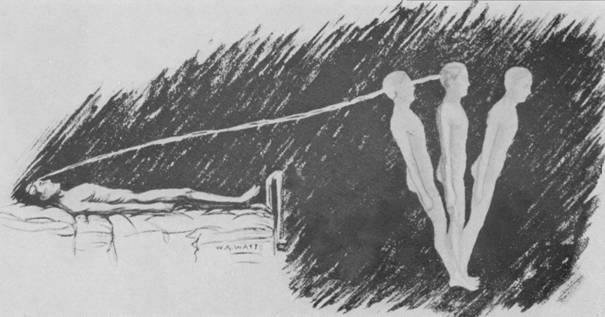
Kinematics
of the phenomenal body image during OBE onset
La
escucha de OOT se trata de un ejercicio de decapamiento de la obra,
de disección de la subjetividad; nuestro juego es el mismo hecho por
Mattin al objetivar sus pensamientos. No se trata de percibir la
construcción del objeto a través de un manierismo enfermizo, sino
de desmantelarlo a través de ese proceso de objetivación del
desmantelamiento de la subjetividad evacuada a través de la voz. Con
el tiempo, encontré que ya no era preciso mantener al margen las
consideraciones formales de la grabación para prestar atención a su
contenido. Su contenido es el vínculo entre el ruido -como caos e
ininteligibilidad- y el propio ruido de sus pensamientos objetivados.
La posibilidad de que irrumpa un
conjunto de frecuencias dañinas para nuestros oídos, sostiene
nuestra tensión durante toda la escucha, pero como en sus previos
trabajos en solitario como “Proletarian of Noise” o “Broken
Subject”, este es el ruido que se encuentra más allá de la ética
del volumen. No encontraremos un pasaje donde se desate un ruido
abisal. El juego se trata de mantener la cuerda tensa, lo más tensa
posible, de trasformar el propio intelecto en mercancía y, a su vez,
tratar de entender cómo somos objetivados a través del capitalismo.
Quizás se trate de un juego esquizoide, con la trampa de no ser
capaz de escapar del “adentro”, de no poder encontrar la grieta
para evacuarnos, pero en cualquier caso, OOT nos deja una copia
carbón de la subjetividad para el análisis. Un objeto/proceso de
despersonalización con huellas de impacto, donde poder buscar una
aproximación a su realidad conceptual y epistemológica.
Recapitulando,
en mi opinión se trata de su disco más refinado junto con el dúo
con Radu Malfatti, Whitenoise, el de mayor intensidad
conceptual, también junto con Attention (en colaboración
con Taku Unami) y, sin duda, el más complejo de su discografía
hasta la fecha.
GegenSichKollektiv
Anti-Copyright
Agosto 2011
1Me
resulta imposible explicar aquí con brevedad y rigor el concepto de
Geotrauma, por eso recomiendo el visionado del vídeo: A Brief
History of Geotrauma or: The Invention of Negarestani,
disponible aquí: http://youtu.be/19V6wDujWyQ
2The
Wire, Issue #286 (Dec 07) | In Writing By: Mark Fisher | Featuring:
Burial
Bad Alchemy (Germany)
MATTIN Object of Thought (Presto!?, P!?016, LP): Mattin leistet
Denkarbeit, als selbstreflektiver dialektischer Materialist. Sein
Material sind Geräusche und Sprache, hörbar gemacht als Schweigen, das
sich hüllt in aleatorische Plops und im Stereoraum zuckende Krakel.
Entstanden in 9 to 5-Sessions, wie die meiste Arbeit, wird erst
allmählich Sprache als das Ausgangsmaterial erkenntlich, ist sie doch
reduziert auf stottrige Impulse und Kürzestkürzel. Mattin argumentiert
nicht, er sucht den direkten Weg ins Hirn, durch Injektionen von
Noise. Erst nach 10 Minuten werden erste Wörter verständlich, halbe
und erste ganze Sätze, die sich überlagern, zu Geflüster reduziert,
gestaucht, gezerrt, umgestülpt, von scharfen Geräuschen weggestrahlt,
ausgeätzt. Die B-Seite beginnt mit aggressiven Noiseschüben,
Breitwandstörungen, Verzerrungen, brachialem Sandstrahlbeschuss,
säurehaltigem Gebrodel. Der Geist war bei Hegel ein Knochen. Hier ist
er Mehl aus einer Knochenmühle, massiv gestörte Radiofrequenz,
schmerzhafter Impuls. Die Plops des Anfangs kehren wieder, auch das
Schweigen. Mattin macht daran seine Widersprüche fest: Improvisation
vs. Dogma, widerspenstige Stupidität vs. dienstbarer Intellekt,
kritisches Denken vs. Metaphysik, Heterogenität vs. Knowledge,
Dezision vs. Kompromiss. Und er wirft Fragen auf - abgedruckt auf dem
Cover - und mit dieser Doppelstrategie der Verschriftung weitere
Fragen: Wie verändert die englische Sprache sein Denken? Wieweit macht
er seine Denkprozesse zur Ware? Bietet Improvisation einen Zugang zu
einem noch nicht kapitalistisch zugerichteten Selbst? Woraus speist
sich Improvisation? Ist Noise ein Botschafter des Unkontrollierten?
Wie gehen Konzept und Improvisation zusammen? Welche Art von
Performanz ist notwendig, damit Kapitalismus und Nihilismus von Innen
heraus überwunden werden können? [ba 68 rbd]







 Mattin,
as anyone who's been following his career will know already, always
makes sure that whatever he releases is also available for free
download, and indeed that's how I've managed to get hold of this one
while I wait to get my paws on the real thing, which is a gorgeous
object in its own right. As he made abundantly clear in his PT
interview last year, Mattin these days seems to be more interested in
the ideas behind music – its social, political and philosophical
implications – than he is in what it actually sounds like. That's a
shame if, like me, you're a boring old fart who still believes in
old-fashioned notions of musical form and content, and music's power to
move the listener in ways s/he can't explain (bourgeois
mystification? you betcha), but it hasn't stopped me from listening
carefully to, and usually enjoying, any Mattin offering that comes my
way.
Mattin,
as anyone who's been following his career will know already, always
makes sure that whatever he releases is also available for free
download, and indeed that's how I've managed to get hold of this one
while I wait to get my paws on the real thing, which is a gorgeous
object in its own right. As he made abundantly clear in his PT
interview last year, Mattin these days seems to be more interested in
the ideas behind music – its social, political and philosophical
implications – than he is in what it actually sounds like. That's a
shame if, like me, you're a boring old fart who still believes in
old-fashioned notions of musical form and content, and music's power to
move the listener in ways s/he can't explain (bourgeois
mystification? you betcha), but it hasn't stopped me from listening
carefully to, and usually enjoying, any Mattin offering that comes my
way.
